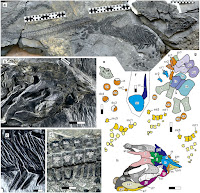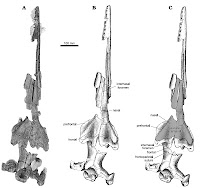England is noted for having produced a large range of Early Jurassic Ichthyosaur specimens, though the majority of these have come from the Jurassic Coast area of Dorset, with specimend also described from Somerset, Leicestershire and Warwickshire. A number of specimens are also known from the Early Jurassic of Nottinghamshire, though to date these have been the subject of little organized study.
In a paper published in the Journal of Systematic Palaeontology on 13 June 2016, Dean Lomax of the School of Earth, Atmospheric and Environmental Sciences at The University of Manchester describes a new species of Ichthyosaur from the Early Jurassic Scunthorpe Mudstone Formation of the Normanton Hills, near Normanton on Soar in the district of Rushcliffe, Nottinghamshire.
The species is described from a single specimen, obtained from the collection of Percy Faulks by the Leicester Arts and Museums Service. The specimen has been prepared mechanically and by acid disolution some time between 1952 and 1981, and is currently in several pieces, with the majority on three large blocks. It is named Wahlisaurus massarae, in honour of William Wahl and Judy Massare for their contributions to the study of Mesozoic Marine Reptiles.
The specimen has variable preservation, with some portions articulated and well preserved, and others completely disarticulated and worn The skull is partially crushed with some portions missing completely. It is thought to be a sub-adult, with only partial fusion of the skull and patches of roughness on the articulating surfaces of the humerus, which would be expected to be smooth in a fully mature specimen.
See also...
 Sclerocormus parviceps: A new species of Ichthyosaur from the Early Triassic of Anhui Province, China. Ichthyosaurs were Marine Reptiles known from the Triassic to the
Cretaceous. They were fully-aquatic with a Dolphin-like form, and known
to have given birth to live young, rather than emerging from the water
to lay eggs, as is the case in Turtles and Crocodiles...
Sclerocormus parviceps: A new species of Ichthyosaur from the Early Triassic of Anhui Province, China. Ichthyosaurs were Marine Reptiles known from the Triassic to the
Cretaceous. They were fully-aquatic with a Dolphin-like form, and known
to have given birth to live young, rather than emerging from the water
to lay eggs, as is the case in Turtles and Crocodiles...
 A new species of Hupehsuchian from the Early Triassic of Hubei Province, China. The Hupehsuchians are a group of Marine Reptiles known only from the
Early Triassic of Hubei Province, China. Their origins and relationships are
obscure, though it has been suggested that they might be...
A new species of Hupehsuchian from the Early Triassic of Hubei Province, China. The Hupehsuchians are a group of Marine Reptiles known only from the
Early Triassic of Hubei Province, China. Their origins and relationships are
obscure, though it has been suggested that they might be...
 A fresh look at the Albian Ichthyosaur Platypterygius hercynicus.
The Ichthyosaurs were a group of marine tetrapods that resembled
dolphins. They appear in the fossil record in the mid-Triassic about 245
million years ago, and survive till the mid-Cretaceous, about 90
million years ago. During the Jurassic they appear to have been the top
marine predators, but in the Cretaceous they were...
A fresh look at the Albian Ichthyosaur Platypterygius hercynicus.
The Ichthyosaurs were a group of marine tetrapods that resembled
dolphins. They appear in the fossil record in the mid-Triassic about 245
million years ago, and survive till the mid-Cretaceous, about 90
million years ago. During the Jurassic they appear to have been the top
marine predators, but in the Cretaceous they were...
Follow Sciency Thoughts on Facebook.
The species is described from a single specimen, obtained from the collection of Percy Faulks by the Leicester Arts and Museums Service. The specimen has been prepared mechanically and by acid disolution some time between 1952 and 1981, and is currently in several pieces, with the majority on three large blocks. It is named Wahlisaurus massarae, in honour of William Wahl and Judy Massare for their contributions to the study of Mesozoic Marine Reptiles.
Basioccipital, rostrum and dentition of Wahlisaurus massarae. (A) Basioccipital in posterior view; note the extensive extracondylar area, fragment of the left stapes and portion of basisphenoid. (B) Ventral view of mandible and snout with anterior portion of dentary rotated (in dorsal view) and positioned adjacent (dashed line indicates point of fit); note the slenderness of the rostrum and the presence of an overbite. (C) Close-up of the large, long and robust teeth and some of the needle-like teeth positioned under the maxilla. (D) Close-up of three dentary teeth; note the ‘waisted’ morphology, recurved crown and infolded root. Abbreviations: bas, basisphenoid; den, dentary; mx, maxilla (right maxilla); pmx, premaxilla; sta, stapes. Scale bars: (A) 5 cm; (B) 10 cm; (C) 3 cm. Lomax (2016).
The specimen has variable preservation, with some portions articulated and well preserved, and others completely disarticulated and worn The skull is partially crushed with some portions missing completely. It is thought to be a sub-adult, with only partial fusion of the skull and patches of roughness on the articulating surfaces of the humerus, which would be expected to be smooth in a fully mature specimen.
See also...
 Sclerocormus parviceps: A new species of Ichthyosaur from the Early Triassic of Anhui Province, China. Ichthyosaurs were Marine Reptiles known from the Triassic to the
Cretaceous. They were fully-aquatic with a Dolphin-like form, and known
to have given birth to live young, rather than emerging from the water
to lay eggs, as is the case in Turtles and Crocodiles...
Sclerocormus parviceps: A new species of Ichthyosaur from the Early Triassic of Anhui Province, China. Ichthyosaurs were Marine Reptiles known from the Triassic to the
Cretaceous. They were fully-aquatic with a Dolphin-like form, and known
to have given birth to live young, rather than emerging from the water
to lay eggs, as is the case in Turtles and Crocodiles... A new species of Hupehsuchian from the Early Triassic of Hubei Province, China. The Hupehsuchians are a group of Marine Reptiles known only from the
Early Triassic of Hubei Province, China. Their origins and relationships are
obscure, though it has been suggested that they might be...
A new species of Hupehsuchian from the Early Triassic of Hubei Province, China. The Hupehsuchians are a group of Marine Reptiles known only from the
Early Triassic of Hubei Province, China. Their origins and relationships are
obscure, though it has been suggested that they might be...  A fresh look at the Albian Ichthyosaur Platypterygius hercynicus.
The Ichthyosaurs were a group of marine tetrapods that resembled
dolphins. They appear in the fossil record in the mid-Triassic about 245
million years ago, and survive till the mid-Cretaceous, about 90
million years ago. During the Jurassic they appear to have been the top
marine predators, but in the Cretaceous they were...
A fresh look at the Albian Ichthyosaur Platypterygius hercynicus.
The Ichthyosaurs were a group of marine tetrapods that resembled
dolphins. They appear in the fossil record in the mid-Triassic about 245
million years ago, and survive till the mid-Cretaceous, about 90
million years ago. During the Jurassic they appear to have been the top
marine predators, but in the Cretaceous they were...Follow Sciency Thoughts on Facebook.

